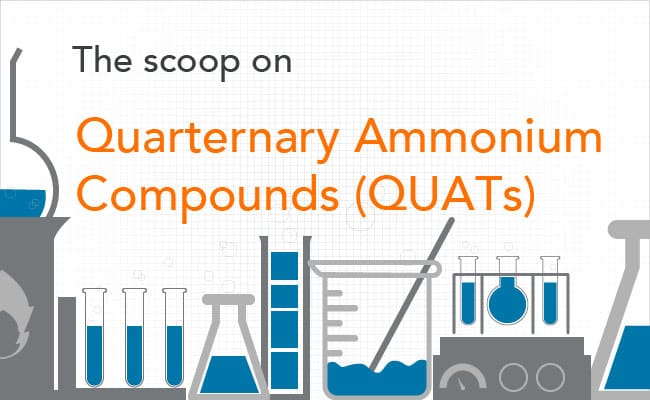
What are quaternary ammonium compounds (otherwise known as quats or QACs)?
Quaternary ammonium compounds, alternately known as quats or QACs, are antimicrobial chemicals that are used in a variety of different products ranging from spermicidal jellies, to dishwashing liquids, hand soaps, air fresheners and disinfectants. They make clothes feel softer after being washed so they’re also a common ingredient in fabric softeners. There are multiple health reasons to avoid using quat-based products.
What are quats or QACs in?
Because they are effective germ-killers that are inexpensive to produce, quats can be found in a wide range of products that we use in our homes every day, including shampoos, toilet cleaners, hand soap, shaving cream, baby wipes, body wash, sunscreens, moisturizers, disinfectant sprays, liquid fabric softeners, and anti-cling dryer sheets.
How to tell if a product has quats or QACs
The quats category contains several different commonly used ingredients. To avoid quats or QACs, avoid products with ingredient labels using the words “quaternium” or “-onium chloride” like benzalkonium chloride, benzethonium chloride, alkyl dimethyl benzyl ammonium chlorides, alkyl dimethyl ethylbenzyl ammonium chloride, didecyldimethylammonium chloride, dioctyldimethylammonium chloride, distearyldimonium chloride, variants of hydroxyethyl methyl ammonium methyl sulfate, diethyl ester dimethyl ammonium chloride, and are often noted as “biodegradable fabric softening agents” or “catatonic surfactants”.
Risks associated with quats or QACs
Quats are formaldehyde releasing toxic chemicals that have been associated with multiple health risks. Quats or QACs have been detected in the blood of the general population and have even been found in breast milk. A recent study showed that children have 14–55 times higher daily uptake of Quats or QACs compared to teenagers and adults due to their more frequent hand-to-mouth contact. Risks include:
- Allergies & irritation (skin, eye, lung)
- Contact dermatitis – Studies estimate that between 13% and 34% of contact dermatitis cases may be linked to quats.
- Asthma- triggering it in those who already have asthma and new onset in people with no prior asthma
- Reproductive and developmental toxicity
- Injuries: eye and mucous membrane injuries from splashes or contact with mists and oral and gastrointestinal injuries from swallowing solutions containing quats
- Promoting “super bugs“. Concerns about quarternary ammonium compounds leading to resistant bacteria stem from how these ingredients interact with bacterial cell membranes.
How to avoid Quats or QACs
Read product labels and avoid products that contain alkyl dimethyl benzyl ammonium chlorides, alkyl dimethyl ethylbenzyl ammonium chloride, didecyldimethylammonium chloride, dioctyldimethylammonium chloride, distearyldimonium chloride, hydroxyethyl methyl ammonium methyl sulfate, diethyl ester dimethyl ammonium chloride, benzalkonium chloride, benzethonium chloride, quaternium-15, guar hydroxypropyltrimonium chloride, centrimonium bromide, polyquaternium – followed by a number (i.e. polyquaternium-7). Also avoid products containing things like “biodegradable fabric softening agents” or “catatonic surfactants”.
Label reading is tough, and in cleaning products, manufacturers aren’t even required to list all their ingredients on product labels. A great alternative to disinfectants with quats is to choose toxic chemical free alternatives with antimicrobial ingredients like hypochlorous acid. Hypochlorous acid is so gentle that it’s commonly used as the antimicrobial in eye care, wound healing, and veterinary care products. In fact, hypochlorous acid is the same substance the immune system produces to fight infection.
In personal care products, a great way to avoid quats is to research a specific product’s ingredients with a resource like the Environmental Working Group’s Skin Deep product database or app.
Wondering about how to protect your home or your business from SARS-CoV-2, the cause of Covid-19, without quats? Almost half of the products on the EPA’s list N, the disinfectants approved for use against Covid-19, contain this category of ingredients. A great option that’s EPA approved for use against Covid-19 is Force of Nature, which uses hypochlorous acid instead. Force of Nature is a small appliance that uses electricity to convert salt, water and vinegar into a multipurpose cleaner and EPA registered disinfectant that kills 99.9% of germs when used as directed. It has no harmful fumes or residues, so you don’t have to worry about rinsing surfaces after you use it. And because you can make it on your countertop, you never have to worry about running out.



